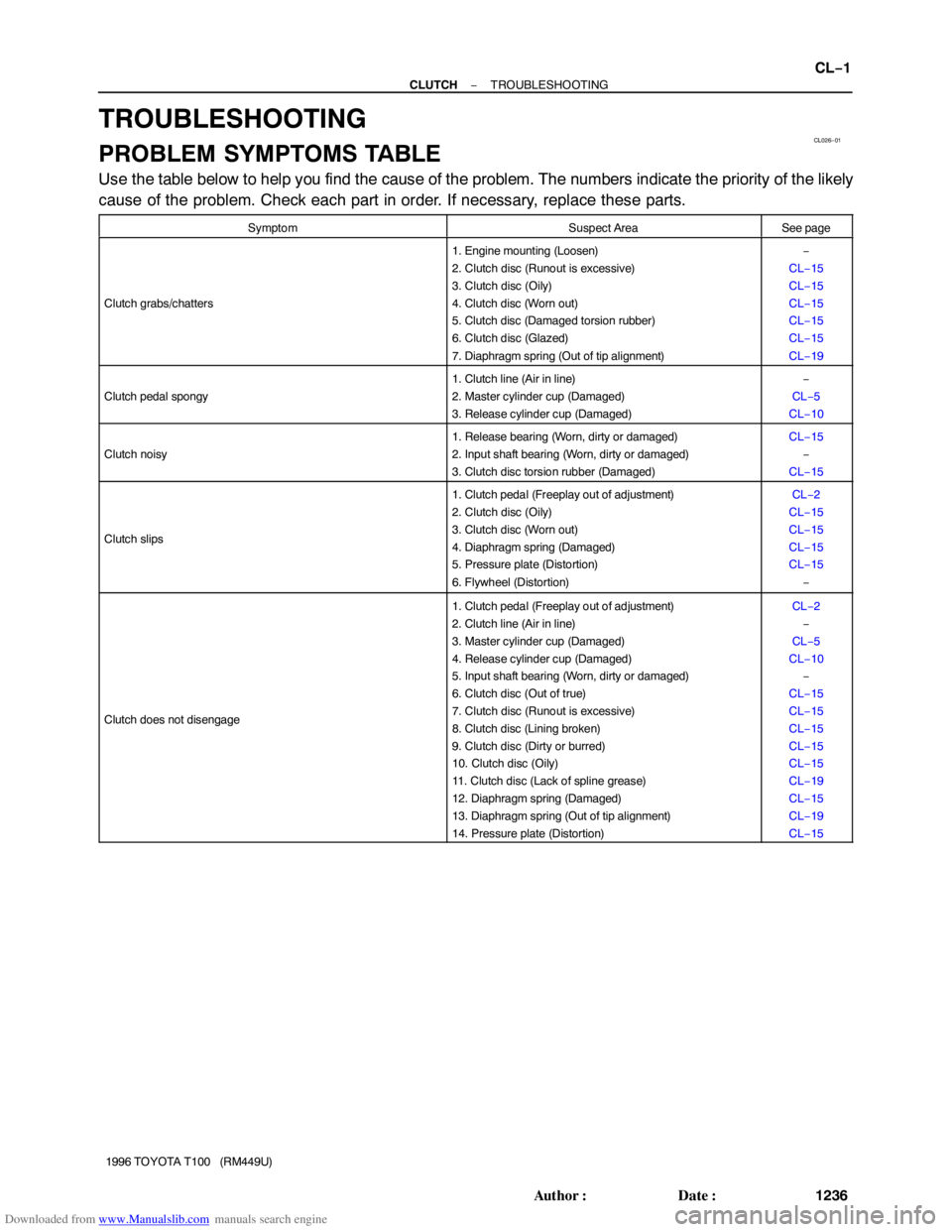Page 1257 of 2062
Downloaded from www.Manualslib.com manuals search engine P13543
B05826
Push
P13397
P13571
− CHARGING (5VZ−FE)GENERATOR
CH−15
1996 TOYOTA T100 (RM449U)
(c) Install the 5 screws until there is a clearance of approx. 1
mm (0.04 in.) between the brush holder and voltage regu-
lator.
Torque: 2.0 N·m (20 kgf·cm, 17 in.·lbf)
(d) Fit the brush holder cover.
7. INSTALL REAR END COVER
(a) Install the end cover with the 3 nuts.
Torque: 4.5 N·m (46 kgf·cm, 40 in.·lbf)
(b) Install the terminal insulator with the nut.
Torque:4.1 N·m (42 kgf·cm, 36 in.·lbf)
8. CHECK THAT ROTOR ROTATES SMOOTHLY
Page 1260 of 2062

Downloaded from www.Manualslib.com manuals search engine CL026−01
− CLUTCHTROUBLESHOOTING
CL−1
1236 Author�: Date�:
1996 TOYOTA T100 (RM449U)
TROUBLESHOOTING
PROBLEM SYMPTOMS TABLE
Use the table below to help you find the cause of the problem. The numbers indicate the priority of the likely
cause of the problem. Check each part in order. If necessary, replace these parts.
SymptomSuspect AreaSee page
Clutch grabs/chatters
1. Engine mounting (Loosen)
2. Clutch disc (Runout is excessive)
3. Clutch disc (Oily)
4. Clutch disc (Worn out)
5. Clutch disc (Damaged torsion rubber)
6. Clutch disc (Glazed)
7. Diaphragm spring (Out of tip alignment)−
CL−15
CL−15
CL−15
CL−15
CL−15
CL−19
Clutch pedal spongy
1. Clutch line (Air in line)
2. Master cylinder cup (Damaged)
3. Release cylinder cup (Damaged)−
CL−5
CL−10
Clutch noisy
1. Release bearing (Worn, dirty or damaged)
2. Input shaft bearing (Worn, dirty or damaged)
3. Clutch disc torsion rubber (Damaged)CL−15
−
CL−15
Clutch slips
1. Clutch pedal (Freeplay out of adjustment)
2. Clutch disc (Oily)
3. Clutch disc (Worn out)
4. Diaphragm spring (Damaged)
5. Pressure plate (Distortion)
6. Flywheel (Distortion)CL−2
CL−15
CL−15
CL−15
CL−15
−
Clutch does not disengage
1. Clutch pedal (Freeplay out of adjustment)
2. Clutch line (Air in line)
3. Master cylinder cup (Damaged)
4. Release cylinder cup (Damaged)
5. Input shaft bearing (Worn, dirty or damaged)
6. Clutch disc (Out of true)
7. Clutch disc (Runout is excessive)
8. Clutch disc (Lining broken)
9. Clutch disc (Dirty or burred)
10. Clutch disc (Oily)
11. Clutch disc (Lack of spline grease)
12. Diaphragm spring (Damaged)
13. Diaphragm spring (Out of tip alignment)
14. Pressure plate (Distortion)CL−2
−
CL−5
CL−10
−
CL−15
CL−15
CL−15
CL−15
CL−15
CL−19
CL−15
CL−19
CL−15
Page 1261 of 2062

Downloaded from www.Manualslib.com manuals search engine Q02464
Push Rod Play Adjust Point
Pedal Height
Adjust Point
Pedal Height
Push Rod
PlayCL027−01
CL0102Pedal Freeplay CL−2
− CLUTCHCLUTCH PEDAL
1237 Author�: Date�:
1996 TOYOTA T100 (RM449U)
CLUTCH PEDAL
INSPECTION
1. CHECK THAT PEDAL HEIGHT IS CORRECT
Pedal height from floor panel:
154.6 − 164.6 mm (6.087 − 6.480 in.)
Pedal height from asphalt sheet:
Extra Cab (4WD): 150.1 − 160.1 mm (5.909 − 6.303 in.)
Others: 153.1 − 163.1 mm (6.027 − 6.421 in.)
2. IF NECESSARY, ADJUST PEDAL HEIGHT
Loosen the lock nut and turn the stopper bolt until the height is
correct. Tighten the lock nut.
3. CHECK THAT PEDAL FREEPLAY AND PUSH ROD
PLAY ARE CORRECT
�Push in on the pedal until the beginning of clutch resis-
tance is felt.
Pedal freeplay: 5.0 − 15.0 mm (0.197 − 0.591 in.)
�Gently push on the pedal until the resistance begins to in-
crease a little.
Push rod play at pedal top:
1.0 − 5.0 mm (0.039 − 0.197 in.)
4. IF NECESSARY, ADJUST PEDAL FREEPLAY AND
PUSH ROD PLAY
(a) Loosen the lock nut and turn the push rod until the free-
play and push rod play are correct.
(b) Tighten the lock nut.
(c) After adjusting the pedal freeplay, check the pedal height.
(d) Connect the air duct and install the lower finish panel.
5. CHECK CLUTCH RELEASE POINT
(a) Pull the parking brake lever and install wheel stopper.
(b) Start the engine and idle the engine.
(c) Without depressing the clutch pedal, slowly shift the shift
lever into reverse position until the gears contact.
Page 1262 of 2062

Downloaded from www.Manualslib.com manuals search engine CL0512
25 mm (0.98 in.) or more
Release
Point
Full Stroke
End Position
Q02465
Clutch
Start Switch
Q00617
8 ± 0.5 mm
(0.31 ± 0.020 in.)
− CLUTCHCLUTCH PEDAL
CL−3
1238 Author�: Date�:
1996 TOYOTA T100 (RM449U)
(d) Gradually depress the clutch pedal and measure the
stroke distance from the point the gear noise stops (re-
lease point) up to the full stroke end position.
Standard distance:
25 mm (0.98 in.) or more
(From pedal stroke end position to release point)
If the distance not as specified, perform the following operation.
�Check pedal height.
�Check push rod play and pedal freeplay.
�Bleed the clutch line.
�Check the clutch cover and disc.
6. CHECK CLUTCH START SYSTEM
(a) Check that the engine does not start when the clutch ped-
al is released.
(b) Check that the engine starts when the clutch pedal is fully
depressed.
If necessary, replace the clutch start switch.
7. CHECK CONTINUITY OF CLUTCH START SWITCH
Check the continuity between terminals when the switch is ON
and OFF.
Switch positionCondition
ON (pushed)Continuity
OFF (free)No Continuity
If continuity is not as specified, replace the switch.
Page 1263 of 2062

Downloaded from www.Manualslib.com manuals search engine Z17110
No continuity
Z17111
No continuity
Z17112No continuity
CL0363
Continuity
CL0364
No continuity CL−4
− CLUTCHCLUTCH PEDAL
1239 Author�: Date�:
1996 TOYOTA T100 (RM449U)
8. CHECK CONTINUITY OF CLUTCH START CANCEL
SWITCH
(a) Check that there is no continuity when connecting the
positive (+) lead from the ohmmeter to terminal 2 and the
negative (−) lead to terminal 1.
(b) Check that there is no continuity when connecting the
positive (+) lead from the ohmmeter to terminal 3 and the
negative (−) lead to terminal 1.
(c) Check the there is no continuity between terminals 2 and
3.
If continuity is not as specified, replace the clutch start cancel
switch.
9. CHECK OPERATION OF CLUTCH START CANCEL
SWITCH
(a) Connect positive (+) lead from the battery to terminal 3
and connect negative (−) lead to terminal 1.
(b) Check that there is no continuity when connecting the
positive (+) lead from the ohmmeter to terminal 2 and the
negative (−) lead to terminal 1.
(c) When pushing the switch, check that the indicator light
connect on and there is continuity between terminal 1 and
2.
(d) Check that there is no continuity between terminals 1 and
2 when disconnect the battery lead.
If continuity is not as specified, replace the clutch start cancel
switch.
Page 1276 of 2062

Downloaded from www.Manualslib.com manuals search engine CL02K−04
CL0239
CL0373
Q07250
Q02481
Q02482
SST
− CLUTCHCLUTCH UNIT
CL−17
1996 TOYOTA T100 (RM449U)
INSPECTION
1. INSPECT CLUTCH DISC FOR WEAR OR DAMAGE
Using calipers, measure the rivet head depth.
Minimum rivet depth: 0.3 mm (0.012 in.)
If necessary, replace the clutch disc.
2. INSPECT CLUTCH DISC RUNOUT
Using a dial indicator, check the disc runout.
Maximum runout: 0.8 mm (0.031 in.)
If necessary, replace the clutch disc.
3. INSPECT FLYWHEEL RUNOUT
Using a dial indicator, check the flywheel runout.
Maximum runout: 0.1 mm (0.004 in.)
If necessary, replace the flywheel.
4. INSPECT PILOT BEARING
Turn the bearing by hand while applying force in the rotation
direction.
If the bearing sticks or has much resistance, replace the pilot
bearing.
HINT:
The bearing is permanently lubricated and requires no clearing
or lubrication.
5. IF NECESSARY, REPLACE PILOT BEARING
(a) Using SST, remove the pilot bearing.
SST 09303−35011
Page 1278 of 2062

Downloaded from www.Manualslib.com manuals search engine CL02L−01
Q06647
5VZ−FE 3RZ−FE
SST Flywheel
Side
Q06958
1,4
7
3
62,58 Matchmarks
Q06641
SST
Z00762
Q06642
− CLUTCHCLUTCH UNIT
CL−19
1996 TOYOTA T100 (RM449U)
INSTALLATION
1. INSTALL CLUTCH DISC AND CLUTCH COVER ON
FLYWHEEL
(a) Insert SST in the clutch disc, and then set them and the
clutch cover in position.
SST 09301−00110
(b) Align the matchmarks on the clutch cover and flywheel.
(c) Torque the 6 bolts on the clutch cover in the order shown.
Torque: 19 N·m (195 kgf·cm, 14 ft·lbf)
HINT:
Temporarily tighten the No.1 and No.2 bolts.
2. CHECK DIAPHRAGM SPRING TIP ALIGNMENT
Using a dial indicator with roller instrument, check the dia-
phragm spring tip alignment.
Maximum non−alignment: 0.5 mm (0.020 in.)
If alignment is not as specified, using SST, adjust the dia-
phragm spring tip alignment.
SST 09333−00013
3. APPLY MOLYBDENUM DISULPHIDE LITHIUM BASE
GREASE (NLGI NO.2)
(a) Apply release hub grease to the these parts.
�Release fork and hub contact point
�Release fork and push rod contact point
�Release fork pivot point
(b) Apply clutch spline grease.
�Clutch disc spline
HINT:
Recommended grease part number 08887−01706 (100g).
4. INSTALL BOOT, RELEASE BEARING AND FORK TO
TRANSMISSION
Install the boot and bearing to the release fork, and then install
them to the transmission.
Page 1282 of 2062

Downloaded from www.Manualslib.com manuals search engine MT04J−01
MT−2
− MANUAL TRANSMISSION (R150, R150F)TROUBLESHOOTING
1257 Author�: Date�:
1996 TOYOTA T100 (RM449U)
TROUBLESHOOTING
PROBLEM SYMPTOMS TABLE
Use the table below to help you find the cause of the problem. The numbers indicate the priority of the likely
cause of the problem. Check each part in order. If necessary, replace these parts.
SymptomSuspect AreaSee page
Noise
1. Oil (Level low) 2WD
4WD
2. Oil (Wrong) 2WD
4WD
3. Gear (Worn or damaged)
4. Bearing (Worn or damaged)MT−4
MT−7
MT−4
MT−7
MT−11
MT−11
Oil leakage
1. Oil (Level too high) 2WD
4WD
2. Gasket (Damaged)
3. Oil seal (Worn or damaged)
4. O−Ring (Worn or damaged)MT−4
MT−7
MT−11
MT−11
MT−11
Hard to shift or will not shift
1. Synchronizer ring (Worn or damaged)
2. Shift key spring (Damaged)MT−22
MT−25
MT−34
MT−25
MT−34
Jumps out of gear
1. Locking ball spring (Damaged)
2. Shift fork (Worn)
3. Gear (Worn or damaged)
4. Bearing (Worn or damaged)MT−11
MT−11
MT−11
MT−11